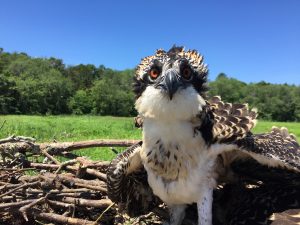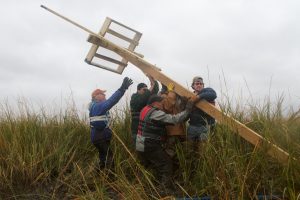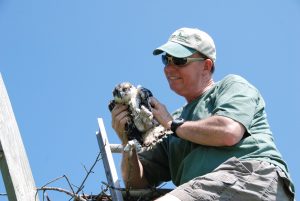
Osprey Recovery Program
Citizens United to Protect the Maurice River and Its Tributaries, Inc.’s Osprey Colony Project is one of our most successful endeavors. It was developed to help reestablish an osprey colony on the Maurice River and its tributaries.
The osprey, often referred to as the fish hawk, is a bird of prey: a raptor. Today the largest concentrations of osprey are found on the northeast coast of the U.S. But in the 1960s their populations plummeted; this marked the beginning of a national environmental crisis. By the ‘70s osprey were considered an endangered species; it was thought they might perish altogether, emptying the skies of osprey making their annual migrations to and from South America.
Research showed that their decline was the result of chemical contamination by DDT (dichlor-diphenyl-trichloroethane). In concentrations up to a million times greater than those found in water, it was affecting the female bird’s hormonal balance and in turn her reproduction. Toxic effects inside the oviduct where the egg is formed caused insufficient calcium, resulting in thin eggshells. The incubation of the eggs could not be successfully completed because the weight of the parent’s body crushed the eggs. As a result, in the early 1970s, of the thousand that had once nested between New York and Boston there were only about one hundred pairs of osprey left. Historically New Jersey had about 500 nests. By 1975 only 50 remained.
Why care? Osprey, like humans, are at the top of a food chain. The osprey’s food chain is an excellent model of our own vulnerabilities to toxins in the environment. The osprey’s decline has long stood as a warning of a need for change; it served as a biological indicator of contaminants in the environment long before the problem was evident in human health records.
Marine biologist Rachel Carson’s 1962 bestseller Silent Spring launched a global environmental movement. In it she warned of the threats associated with dichlor-diphenyl-trichloroethane (DDT) and other synthetic chemicals. Ultimately, these realities led to the 1973 banning of DDT by the EPA. This has long been viewed as the catalyst for current environmental law.
The intervention by humans using wildlife management techniques has been the hallmark of osprey recovery. Along with a ban on DDT, one of the key ingredients to recovery has been the construction of nesting platforms. New Jersey now hosts over 500 nests. Osprey are no longer listed as endangered in NJ but now have the improved status of threatened.
However, osprey are not out of danger yet. On the Delaware Bayshore, NJ Endangered and Nongame Species Program biologists have documented a failing colony due to DDE, a derivative of DDT. And on the Atlantic Coast during the summers of 1997 and 1998 there were severe nest failures, possibly linked to food supply.

In 1986 CU Maurice River’s first pilot nest was erected on the Maurice River. Prior to that time one or two nests were erected by New Jersey Fish, Game and Wildlife, with about 3-6 chicks fledging annually. Since 1986, Citizens United has erected over 57 nests in our watershed. In addition to these nests we have constructed 8 for the NJ Bureau of Emergency Response for the top of oilspill boom pilings, 2 for the Natural Lands Trust (outside the watershed), 9 for NJ Division of Fish, Game and Wildlife, 10 for Community Energy, and 25 for Public Service Electric and Gas Co.’s Estuary Enhancement program.
Our nesting platform is now NJ’s official design. It is hoped that its distinctive “Y” shape looks more like a crook in a tree than a telephone pole where osprey are often electrocuted. Osprey are known for the wide array of places in which they construct nests. Since birds imprint to the structures in which they are raised, the “Y” shape may entice young pairs to use trees rather than current-carrying utility structures. The “Y” shape also offers perches for the adults to watch over the nest, or simply to get out of the way of the commotion the older chicks can create.

From our humble beginnings in 1986 we now manage over 40 nesting platforms that fledge over 80 chicks per year. This program has been made possible through the efforts of hundreds of CU Maurice River volunteers over the years. Furthermore, the Endangered and Nongame Species program keeps records of 118 nests, which include those on our river along with the adjacent Delaware Bayshore nests (2016). This is truly a success story!
Explore the Osprey Recovery section of our website. You’ll find nesting platform construction plans, predator guard plans, fun stories on the different nests along our river, podcasts, a slide show of the weekly growth of osprey chicks, and even see a great horned owl rob a juvenile osprey – all this and more!
